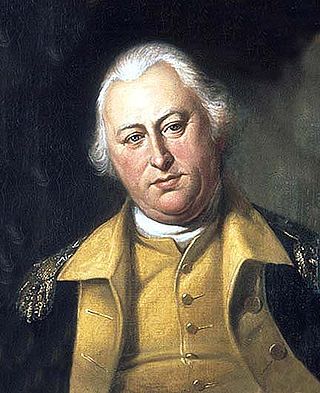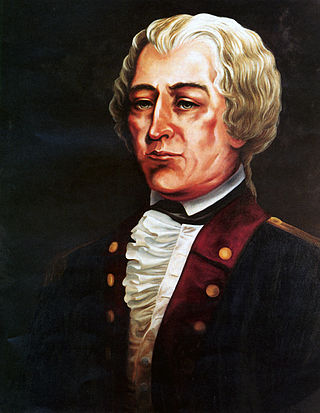Related Research Articles

The Continental Army was the army of the United Colonies representing the Thirteen Colonies and later the United States during the American Revolutionary War. It was formed on June 14, 1775 by a resolution passed by the Second Continental Congress, meeting in Philadelphia after the war's outbreak. The Continental Army was created to coordinate military efforts of the colonies in the war against the British, who sought to maintain control over the American colonies. General George Washington was appointed commander-in-chief of the Continental Army and maintained this position throughout the war.

Peter Gansevoort was a Colonel in the Continental Army during the American Revolutionary War. He is best known for leading the resistance to Barry St. Leger's Siege of Fort Stanwix in 1777. Gansevoort was also the maternal grandfather of Moby-Dick author Herman Melville.

Philip John Schuyler was an American general in the Revolutionary War and a United States Senator from New York. He is usually known as Philip Schuyler, while his son is usually known as Philip J. Schuyler.

Benjamin Lincoln was an American army officer. He served as a major general in the Continental Army during the American Revolutionary War. Lincoln was involved in three major surrenders during the war: his participation in the Battles of Saratoga contributed to John Burgoyne's surrender of a British army, he oversaw the largest American surrender of the war at the 1780 siege of Charleston, and, as George Washington's second in command, he formally accepted the British surrender at Yorktown.

The King's Royal Regiment of New York, also known as Johnson's Royal Regiment of New York, King's Royal Regiment, King's Royal Yorkers, and Royal Greens, were one of the first Loyalist regiments, raised on June 19, 1776, in British Canada, during the American Revolutionary War.
The 2nd Albany County Militia Regiment was the local militia unit for Schenectady, New York, during the American Revolutionary War under the command of Colonel Abraham Wemple. The regiment saw action with the Continental Army in 1777 at the Battle of Saratoga in General John Glover's brigade. It was called out to fight against the loyalist and their Indian allies at the Battle of Klock's Field on October 19, 1780, and Battle of Johnstown on October 25, 1781. A member from the 2nd Albany may have been the person who killed the Loyalist officer Walter Butler of Butler's Rangers on October 30, 1781, during a skirmish.
The 8th North Carolina Regiment was authorized on November 26, 1776, and assigned to the Southern Department of the Continental Army. The 8th North Carolina Regiment played a crucial role in the Defense of Philadelphia during the Philadelphia campaign. The unit saw action at the Battle of Brandywine, Battle of Germantown and the Battle of Monmouth during the Defense of Philadelphia of the American Revolution. A part of the continental army, the Regiment was commanded by Colonel James Armstrong. The regiment was disbanded on 1 June 1778 at Valley Forge, Pennsylvania.
The Van Alstyne's Regiment of Militia, also known as the 7th Albany County Militia Regiment, was called up in July, 1777 at Kinderhook, New York to reinforce Gen. Horatio Gates's Continental Army during the Saratoga Campaign. The regiment served in Brigadier General Abraham Ten Broeck's Brigade. With the defeat of General John Burgoyne's British Army on October 17, 1777, the regiment stood down. It is uncertain whether the regiment participated in the October 7 Battle of Bemis Heights, and if it did, whether the entire regiment was there.
The Van Bergen's Regiment of Militia, also known as the 11th Albany County Militia Regiment, was called up in July, 1777 at Coxsackie, New York to reinforce General Horatio Gates's Continental Army during the Saratoga Campaign. The regiment served in Brigadier General Abraham Ten Broeck's Brigade. With the defeat of General John Burgoyne's British Army on October 17, 1777, the regiment stood down.
The Vandenbergh's Regiment of Militia, also known as the 5th Albany County Militia Regiment, was called up in July, 1777 at Rennselaerwyck, New York to reinforce Gen. Horatio Gates's Continental Army during the Saratoga Campaign. The regiment served in Brigadier General Abraham Ten Broeck's Brigade. With the defeat of General John Burgoyne's British Army on October 17, 1777 the regiment stood down.
The Van Ness' Regiment of Militia, also known as the 9th Albany County Militia Regiment, was called up in July, 1777 at Claverack, New York to reinforce Gen. Horatio Gates's Continental Army during the Saratoga Campaign. The regiment served in Brigadier General Abraham Ten Broeck's Brigade. With the defeat of General John Burgoyne's British Army on October 17, 1777 the regiment stood down.
The Van Schoonoven's Regiment of Militia, also known as the 12th Albany County Militia Regiment, was called up in July 1777 at Halfmoon, New York, to reinforce Gen. Horatio Gates's Continental Army during the Saratoga Campaign. The regiment served in Brigadier General Abraham Ten Broeck's brigade. With the defeat of General John Burgoyne's British Army on October 17, 1777, the regiment stood down.

John Doughty was an American military officer who briefly served as the senior officer of the United States Army in 1784. Holding the rank of major at the time, he bears the distinction of being the lowest ranked individual ever to serve as the senior most United States Army officer.
The creation of the Tryon County, New York militia was authorized on March 8, 1772, when the Province of New York passed a bill for the establishment of organized militia in each county in the colony. By 1776, the Tryon County militia had in effect become an army of rebellion under the control of the Tryon County Committee of Safety. The Tryon County militia would go on to fight at the important battles of Oriskany and Johnstown during the war.
The New York Provincial Congress (1775–1777) was a revolutionary provisional government formed by colonists in 1775, during the American Revolution, as a pro-American alternative to the more conservative New York General Assembly, and as a replacement for the Committee of One Hundred. The Fourth Provincial Congress, resolving itself as the Convention of Representatives of the State of New York, adopted the first Constitution of the State of New York on April 20, 1777.
The northern theater of the American Revolutionary War also known as the Northern Department of the Continental Army was a theater of operations during the American Revolutionary War.
Events from the year 1777 in the United States.